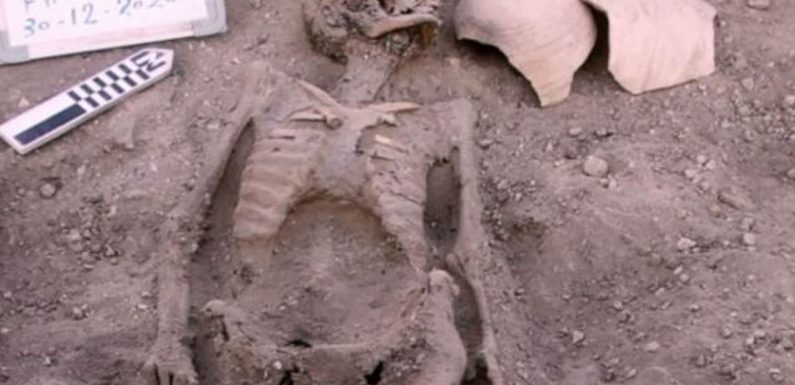
It’s been dubbed as the biggest archaeological discovery since King Tut’s tomb nearly a century ago.
On Thursday, Egypt announced what has been described as the discovery of the ‘Lost Golden City’ in the southern province of Luxor.
The seven-month excavation mission, which was lead by Egypt’s former antiquities chief Zahi Hawass, discovered “several areas or neighbourhoods” which date back around 3000 years.
According to reports, the original mission was to find King Tut’s temple of rest, however instead, the archaeological team found parts of an entire city.
“The excavation started in September 2020 and within weeks, to the team’s great surprise, formations of mud bricks began to appear in all directions,” Egypt’s antiquities ministry said in a statement.
“What they unearthed was the site of a large city in a good condition of preservation, with almost complete walls, and with rooms filled with tools of daily life.”
Archaeological discoveries are seen in Luxor, Egypt. Picture: Zahi Hawass Centre For Egyptology via ReutersSource:Reuters
Phenomenal find dates to Pharaoh Amenhotep III
According to National Geographic, the site dates from the era of 18th-dynasty pharaoh Amenhotep III, who ruled between around 1386 and 1353BC. The discovery has impressed researchers and experts around the world, who say the ruins are “the largest administrative and industrial settlement in the era of the Egyptian empire on the western bank of Luxor”.
“There’s no doubt about it; it really is a phenomenal find,” Salima Ikram, an archaeologist who leads the American University in Cairo’s Egyptology unit, told National Geographic.
“It’s very much a snapshot in time – an Egyptian version of Pompeii.”
Some of the evident parts of the southern part of the city includes a bakery, ovens and storage pottery while the northern part, most of which still remain under the sands, includes administrative and residential districts.
“The discovery of the Lost City, not only will give us a rare glimpse into the life of the Ancient Egyptians at the time where the Empire was at its wealthiest but will help us shed light on one of history’s greatest mystery: Why did Akhenaten and Nefertiti decide to move to Amarna,” Betsy Bryan, professor of Egyptology at Johns Hopkins University in Baltimore, told US ABC News.
Archaeological discoveries sit among the dig in Luxor, Egypt, in this undated handout photo. Picture: Zahi Hawass Centre For Egyptology via ReutersSource:Reuters
Skeletal human remains sit in the archaeological dig site in Luxor, Egypt. Picture: Zahi Hawass Centre For Egyptology via ReutersSource:Reuters
A glimpse into regular Ancient Egyptian life
Archaeologist Dr Craig Barker from the University of Sydney said the discovery was perhaps even “more significant” than the discovery of Tutankhamun’s tomb back in 1922.
“It’s an insight into a whole range of aspects of Egyptian society as opposed to just the very elites,” Dr Barker told the ABC on Friday.
“This is an insight into residential life, domestic life, presumably across a wide range of Egyptian society. It’s a real insight into a particular time in the history of Egypt, a very
important time in the history of the New Kingdom. It has the potential to be a very significant archaeological site that will raise a whole lot of questions and interesting research into administrative, political, religious and daily life.”
A new archaeological discovery stands in Luxor, Egypt. Picture: Zahi Hawass Centre For Egyptology via ReutersSource:Reuters
Dr Barker said he believes that a discovery like this in Egypt proves that in archaeology, we have “barely scratched the surface” and that this finding will be a “positive impact” for Egypt’s tourism industry amid the pandemic.
“The positive impact is remarkable,” Dr Barker said.
“Egypt needs this type of announcement, as part of their rebuilding of their tourist industry, particularly after COVID, but especially after a decade of turmoil.
“This is part of a whole suite of announcements that we have seen and I think we’ll see in coming months, to really get the world excited and energised again about how much ancient Egypt has to offer for us.”
trending in travel
Source: Read Full Article














